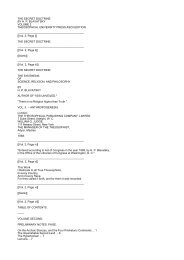You also want an ePaper? Increase the reach of your titles
YUMPU automatically turns print PDFs into web optimized ePapers that Google loves.
The Gods Of The <strong>Book</strong> Of The <strong>Dead</strong>.<br />
In <strong>the</strong> judgment scene in <strong>the</strong> <strong>Book</strong> <strong>of</strong> <strong>the</strong> <strong>Dead</strong>, grouped round <strong>the</strong> pan <strong>of</strong> <strong>the</strong> balance which contains <strong>the</strong><br />
heart <strong>of</strong> <strong>the</strong> deceased (see Plate III.), are three beings in human form, who bear <strong>the</strong> names Shai, Renenet,<br />
and Meskhenet.<br />
Shai is <strong>the</strong> personification <strong>of</strong> destiny, and Renenet fortune; <strong>the</strong>se names are usually found coupled. Shai<br />
and Renenet are said to be in <strong>the</strong> hands <strong>of</strong> Thoth, <strong>the</strong> divine intelligence <strong>of</strong> <strong>the</strong> gods; and Rameses II.<br />
boasts that he himself is "lord <strong>of</strong> Shai and creator <strong>of</strong> Renenet."[3] Shai was originally <strong>the</strong> deity who<br />
"decreed" what should happen to a man, and Renenet, as may be seen from <strong>the</strong> pyramid texts,[4] was <strong>the</strong><br />
goddess <strong>of</strong> plenty, good fortune, and <strong>the</strong> like; subsequently no distinction was made between <strong>the</strong>se<br />
deities and <strong>the</strong> abstract ideas which <strong>the</strong>y represented. In <strong>the</strong> papyrus <strong>of</strong> Ani, Shai stands by himself near<br />
<strong>the</strong> pillar <strong>of</strong> <strong>the</strong> Balance, and Renenet is accompanied by Meskhenet, who appears to be <strong>the</strong><br />
personification <strong>of</strong> all <strong>the</strong> conceptions underlying Shai and Renenet and something else besides. In <strong>the</strong><br />
story <strong>of</strong> <strong>the</strong> children <strong>of</strong> Ra, as related in <strong>the</strong> Westcar papyrus, we find <strong>the</strong> goddess Meskhenet mentioned<br />
with Isis, Nephthys, Heqet, and <strong>the</strong> god Khnemu as assisting at <strong>the</strong> birth <strong>of</strong> children.<br />
[1. Recueil de Travaux, t. iii., p. 182 (l. 17).<br />
2. ###, etc. Ibid., t. vii., p. 170 (l. 463).<br />
3. See Maspero, Romans et Poésies du Papyrus Harris, No. 500, Paris, 1879, p. 27.<br />
4 Pyramid <strong>of</strong> Unas, l. 564.]<br />
{p. cxxvi}<br />
Disguised in female forms, <strong>the</strong> four goddesses go to <strong>the</strong> house <strong>of</strong> Ra-user, and, pr<strong>of</strong>essing to have a<br />
knowledge <strong>of</strong> <strong>the</strong> art <strong>of</strong> midwifery, <strong>the</strong>y are admitted to <strong>the</strong> chamber where <strong>the</strong> child is about to be born;<br />
Isis stands before <strong>the</strong> woman, Nephthys behind her, and Heqet accelerates <strong>the</strong> birth. When <strong>the</strong> child is<br />
born Meskhenet comes and looking upon him says, "A king; he shall rule throughout this land. May<br />
Khnemu give health and strength to his body."[1] The word meskhenet is as old as <strong>the</strong> pyramid times,<br />
and seems <strong>the</strong>n to have had <strong>the</strong> meaning <strong>of</strong> luck, destiny, etc.[2]<br />
The god Amen, his wife Mut and <strong>the</strong>ir associate Khonsu have nothing whatever to do with <strong>the</strong> <strong>Book</strong> <strong>of</strong><br />
<strong>the</strong> <strong>Dead</strong>; but Amen, <strong>the</strong> first member <strong>of</strong> this great Theban triad, must be mentioned with <strong>the</strong> o<strong>the</strong>r gods,<br />
because he was usually identified with one or more <strong>of</strong> <strong>the</strong>m. The name Amen means <strong>the</strong> "hidden one,"<br />
and <strong>the</strong> founding <strong>of</strong> <strong>the</strong> first shrine <strong>of</strong> <strong>the</strong> god recorded in history took place at Thebes during <strong>the</strong> XIIth<br />
dynasty; from that time until <strong>the</strong> close <strong>of</strong> <strong>the</strong> XVIIth dynasty, Amen was <strong>the</strong> chief god <strong>of</strong> Thebes and<br />
nothing more. When, however, <strong>the</strong> last kings <strong>of</strong> <strong>the</strong> XVIIth dynasty had succeeded in expelling <strong>the</strong><br />
so-called Hyksos and had delivered <strong>the</strong> country from <strong>the</strong> yoke <strong>of</strong> <strong>the</strong> foreigner, <strong>the</strong>ir god assumed an<br />
importance hi<strong>the</strong>rto unknown, and his priests endeavoured to make his worship <strong>the</strong> first in <strong>the</strong> land. But<br />
Amen was never regarded throughout <strong>the</strong> entire country as its chief god, although his votaries called him<br />
<strong>the</strong> king <strong>of</strong> <strong>the</strong> gods. The conception which <strong>the</strong> Thebans had <strong>of</strong> <strong>the</strong>ir god as a god <strong>of</strong> <strong>the</strong> underworld was<br />
modified when <strong>the</strong>y identified him with Ra and called him "Amen-Ra"; and, speaking generally, in <strong>the</strong><br />
time <strong>of</strong> <strong>the</strong> XVIIIth dynasty and onwards <strong>the</strong> god became <strong>the</strong> personification <strong>of</strong> <strong>the</strong> mysterious creating<br />
and sustaining power <strong>of</strong> <strong>the</strong> universe, which in a material form was typified by <strong>the</strong> sun. By degrees all<br />
<strong>the</strong> attributes <strong>of</strong> <strong>the</strong> old gods <strong>of</strong> Egypt were ascribed to him, and <strong>the</strong> titles which among western nations<br />
are given to God were added to those pan<strong>the</strong>istic epi<strong>the</strong>ts which Amen had usurped. The following<br />
extracts from a fine hymn[3] will set forth <strong>the</strong> views <strong>of</strong> <strong>the</strong> priesthood <strong>of</strong> Amen-Ra concerning <strong>the</strong>ir god.<br />
http://www.sacred-texts.com/egy/ebod/ebod09.htm (14 <strong>of</strong> 19) [8/10/2001 11:23:59 AM]

















